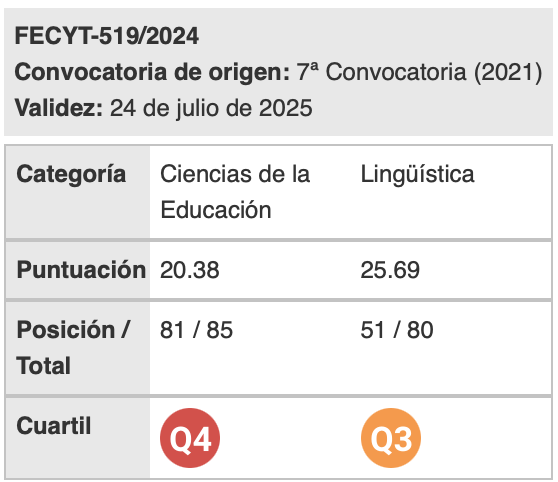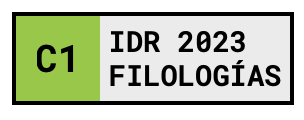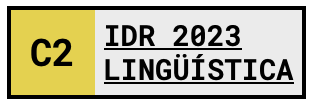The Different Forms of Concept Representation in Terminology: A Study of Documents Addressed to Fighter Aircraft Mechanics
Keywords:
terminology, terminography, concept representation, concept relationship, aero-nauticsAbstract
In this article I present research on different forms of concept representation in specialized aeronautical documents. I have isolated a sample of concepts in Spanish documents addressed to fighter aircraft mechanics in the area of fighter aircraft fuel systems. I have created a terminological database comprising these concepts and their representations, i.e., terms, explanations and illustrations. The analysis of this terminographic work allows us to determine the degree of impor- tance to the expert of the different forms of concept representation and the relationships between them.
Downloads
References
Almela Pérez, R. (1999). Procedimientos de formación de palabras en español, Barcelona,
Ariel.
Arntz, R. and H. Picht (1995). Introducción a la Terminología. Translated by A. de Irazazábal, M. J. Jiménez; E. Schwarz and S. Junquera, Madrid, Fundación Germán Sánchez Ruipérez.
Galinski, Ch. and G. Budin (1998). «Introducción». In Wüster, E. Introducción a la teoría general de la terminología y a la lexicografía terminológica, Barcelona, IULA, Universitat Pompeu Fabra, p. 15-17.
Ghenghea, V. A. (1998). «The Impact of Effective Diagram Design on LSP Text Understanding», In Lundquist, L.; H. Picht and J. Qvistgaard (eds.) Proceedings of the 11th European Symposium on LSP Identity and Interface Research, Knowledge and Society, Copenhagen, Copenhagen Business School, p. 783-793.
Greco, A. (ed.) (1995). «General Aspects of the Concept of Representation», Cogni- tive Systems, Génova, p. 372-129.
ISO 1087-1 (2000). Terminology work – Vocabulary – Part 1 Theory and application. Partial revision of ISO 1987-1990, Suiza, ISO.
(2000). Terminology work-Principles and methods, Suiza, ISO.
Johns, A. M. (1998). «The Visual and the Verbal: a Case Study in Macroeco-
nomics». English for Special Purposes, Oxford, Pergamon, 17-2, p. 183-197.
Kalverkämper, H. (1993). «Das fachliche Bild: Zeichenprozessse in der Darste- llung wissenschaftlicher Ergebnisse», In Schröder, H. (eds.) Fachtextpragmatik. (FFF 19), Tübingen, Gunter Narr Verlag, p. 215-238.
Laurén, Ch. (1998). «Repräsentionsformen für Begriffe und Phänomene». In Laurén, Ch.; J. Myking and H. Picht. IITF Series 9: Terminologie unter der Lupe: Vom Grenzgebiet zum Wissenschaftszweig, Wien, TermNet, p. 186-209.
Maestranza aérea de Albacete (2002). Prontuario para mecánico de línea del avión, Madrid, Negociado de Instrucción Escuadrón de mantenimiento Ala 14.
— (1999). Cartas de trabajo: Instalación propulsora del avión F 18, Madrid, Ministerio de Defensa [Restringido]
Ministerio de Defensa (2000). Manual de mantenimiento: Instalación propulsora del avión F 18, Madrid, Ministerio de Defensa [Restringido].
Miller, T. (1998). «Visual persuasion: A comparison of visuals in academic texts and the popular press». English for Special Purposes, Oxford, Pergamon, 17-1, p. 29-46.
Monterde Rey, A. M. (2003a). Relationships and Dependencies Between Different Forms of Concept Representation: Study in Three Levels of Specialisation of Texts on Aircraft Fuel-System Intallations [Relaciones y dependencias entre distintas formas de representación conceptual: estudio en tres niveles de especialización en textos sobre instalaciones de com- bustible de aviones], Michigan, ProQuest.
— (2003b). «Creación de un programa informático generador de sistemas de conceptos como apoyo a la enseñanza de la Terminología». En: Gallardo San Salvador, N. (dir.) Terminología y traducción: Un bosquejo de su evolución, Granada, Atrio, p. 91-106.
— (2004). «Importancia de la ilustración para la traducción técnica: estudio en el campo de la aeronáutica». En: Gonzalo García, C. and V. García Yebra (eds.) Manual de Documentación y Terminología para la Traducción Especializada, Madrid, Arco/ Libros, p. 259-274 [Colección Instrumenta Bibliologica].
Montes Serrano, C. (1992). Representación y Análisis Formal Lecciones de Análisis de Formas, Valladolid, Universidad de Valladolid, Secretariado de Publicaciones.
Önorm, A. 2704 (1990). Terminologie. Allgemeine Grundsätze für Begriffe und Bezeichnungen, Wien, ÖNORM.
Picht, H. (1992). «On concept and concept representation with focus on non- linguistic forms of representation». In Draskau, J. K. and H. Picht (eds.) IITF Series 4. International Conference on Terminology Science and Terminology Planning. Riga 17-19 August 1992 International IITF-Workshop Theoretical Issues of Terminology Science. Riga 19-21 August 1992, Vienna, Termnet, p. 231-254.
— (1994). «Die Anwendung graphisch figurativer Mittel bei der Begriffsrepräsen- tation». In Brekke, M.; Andersen; T. Dahl and J. Myking (eds.) 1994. Proceedings of the 9th European Symposium on Language for Special Purposes Applications and Implications of Current LSP Research, Bergen, Universitetet i Bergen, Norges Handelshøyskole, 1993, II, p. 932-941 [Workshop II Verbal Concept Representation].
— (2002). «La representación de objetos y conceptos». In Guerrero Ramos, G. and M. F. Pérez Lagos (eds.) Panorama actual de la Terminología, Granada, Comares, p. 275-305.
Sperber, D. and D. Wilson. (1995). Relevance: communication and cognition. 2nd ed, Oxford, Basil Blackwell.
Stockinger, P. (1993). «Conceptual analysis, knowledge management, and con- ceptual graph theory». Lenguas Modernas, Chile, Universidad de Chile, 20, p. 5-53.
Thornton, C. (1996). «Representing representation». In Peterson, D. (ed.) Forms of Representation: An interdisciplinary Theme for Cognitive Science, Wiltshire, Intellect, p. 152-162
Walpole R. E. and R. H. Myers. (1992). Probabilidad y estadística. 4th ed, Méjico, McGraw Hill Interamericana de Méjico.
Wüster, E. (1985). Einführung in die Allgemeine Terminologielehre und die Terminologische Lexikographie. 2nd reed, HEPA-try, Copenhagen.
Downloads
Published
How to Cite
Issue
Section
License
Authors who publish with this journal agree to the following terms:
- Authors retain copyright and grant the journal right of first publication with the work simultaneously licensed under a Creative Commons Attribution License that allows others to share the work with an acknowledgement of the work's authorship and initial publication in this journal.
- Authors are able to enter into separate, additional contractual arrangements for the non-exclusive distribution of the journal's published version of the work (e.g., post it to an institutional repository or publish it in a book), with an acknowledgement of its initial publication in this journal.
- Authors are permitted and encouraged to post their work online (e.g., in institutional repositories or on their website) prior to and during the submission process, as it can lead to productive exchanges, as well as earlier and greater citation of published work (See The Effect of Open Access).

Revista de Lenguas para fines específicos is licensed under a Creative Commons Reconocimiento-NoComercial-SinObraDerivada 4.0 Internacional License.
























